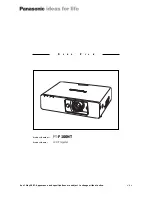
DPX-530
3
DPX-1200DPX-530
The solder used in the production of this product contains LEAD. In addition, other electrical/electronic and/or plastic
(where applicable) components may also contain traces of chemicals found by the California Health and Welfare Agency
(and possibly other entities) to cause cancer and/or birth defects or other reproductive harm.
DO NOT PLACE SOLDER, ELECTRICAL/ELECTRONIC OR PLASTIC COMPONENTS IN YOUR MOUTH FOR ANY
REASON WHATSOEVER!
Avoid prolonged, unprotected contact between solder and your skin! When soldering, do not inhale solder fumes or
expose eyes to solder/flux vapor!
If you come in contact with solder or components located inside the enclosure of this product, wash your hands before
handling food.
■
PRECAUTIONS FOR RESOLDERING
■
WARNING: CHEMICAL CONTENT NOTICE!
Lead free solder is handled in a different way from lead solder. See below for details.
How to distinguish circuit boards using lead free solder from those using
lead solder
Circuit boards using lead free solder
A mark of
Pb Solder
or
LFS
(for limited marking space) is printed near the board assembly number on the component side.
Circuit boards using lead solder
Circuit boards using lead solder are divided into two groups.
- Boards having no mark of
Pb Solder
or
LFS
(for limited marking space) near the board assembly number.
- Boards having a mark of
Pb Solder
or
LFS
(for limited marking space) that is painted out by a marker near the board
assembly number.
* Circuit boards using lead free solder and those using lead solder may be used together in the same product.
Instructions for resoldering
Europe, other than USA
NOTICE: Observe all cautions and safety related notes located inside the cabinet and on the chassis.
Warning
1. An isolation transformer should be used between the projector and the AC supply point before any test/service is performed
on a LIVE chassis projector.
2. Operation of this projector outside the cabinet or with the cover removed, involves a shock hazard from the projector power
supplies. Work on the projector should not be attempted by anyone who is not thoroughly familiar with precautions
necessary when working on high voltage equipment.
3. When service is required, observe the original lead dressing. Extra precaution should be given to assure correct lead
dressing in the high voltage area. Where a short-circuit has occurred, replace those components that indicate evidence of
overheating.
Leakage current cold check
Before returning the projector to the customer, it is recommended that leakage current be measured according to the following
methods.
With the AC plug removed from the AC source, place a jumper across the two AC plug prongs. Turn the projector AC switch on.
Using an 500 V D.C. Insulation Tester, connect one lead to the jumpered AC plug and touch the other lead to each exposed
metal part (screwheads, etc.), particularly any exposed metal part having a return path to the chassis. Exposed metal parts
having a return path to the chassis should have a minimum resistance reading of 4 megohm. Any resistance below this value
indicates an abnormality which requires corrective action.
Caution:
1. As the melting point temperature of the lead free solder is about 30
°
C to 40
°
C (50
°
F to 70
°
F) higher than that of the lead solder,
be sure to use a soldering iron suitable to each solder.
2. If lead solder must be used, be sure to remove lead free solder from each terminal section of the parts to be replaced and from the
area around it completely before soldering, or make sure that the lead free solder and lead solder melt together fully.
Among some types of lead free solder currently available, it is recommended to use one of the following types for the repair work.
• Sn + Ag + Cu (tin + copper)
• Sn + Cu (tin + copper)
• Sn + Zn + Bi (tin + zinc + bismuth)
Содержание DPX-530
Страница 48: ...48 DPX 530 MEMO ...
Страница 72: ...DPX 530 DPX 530 ...




































